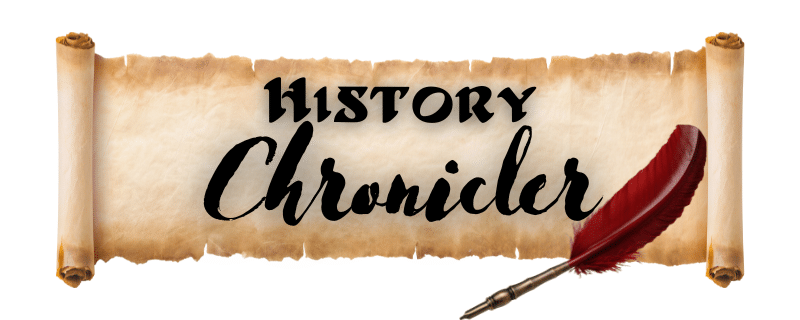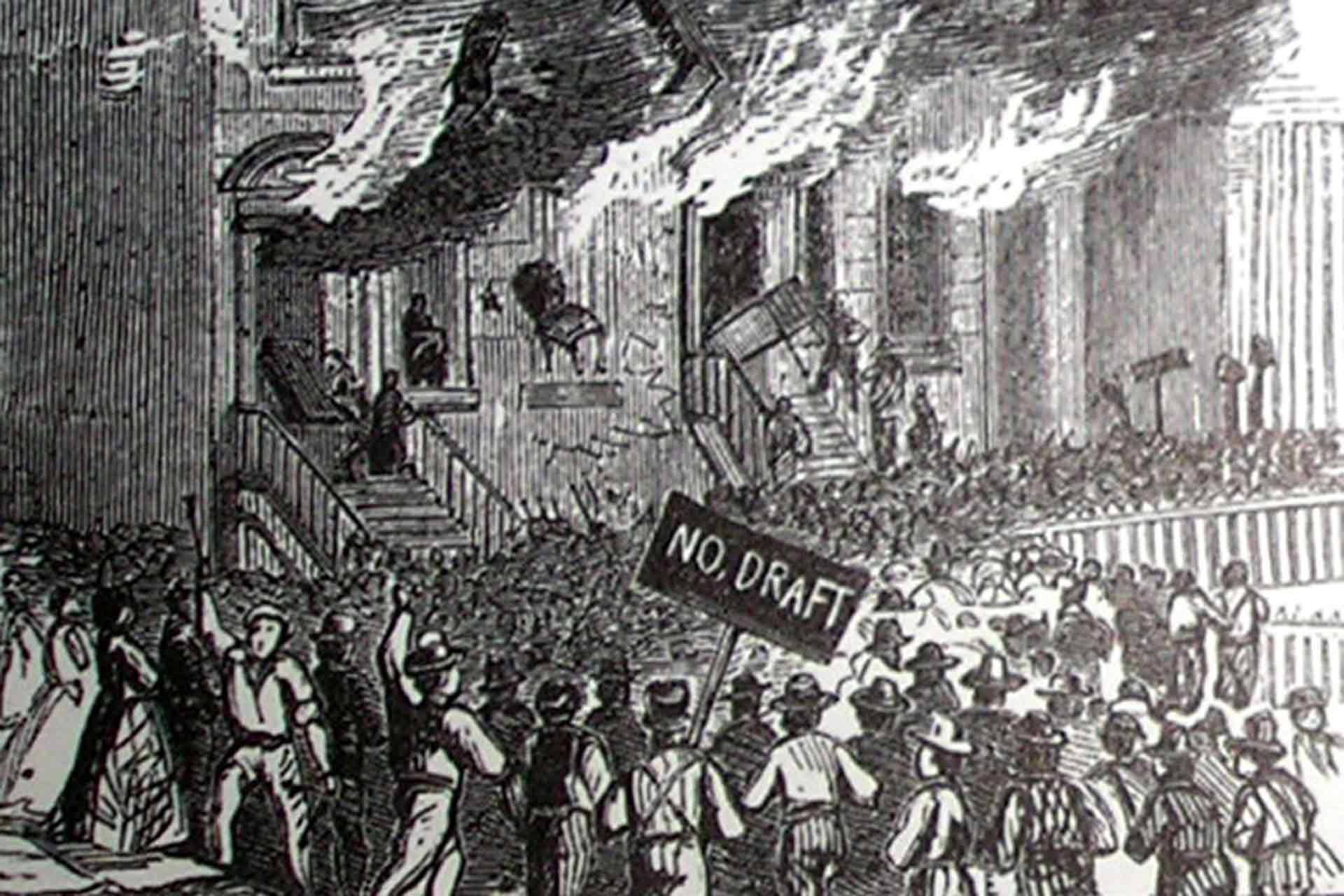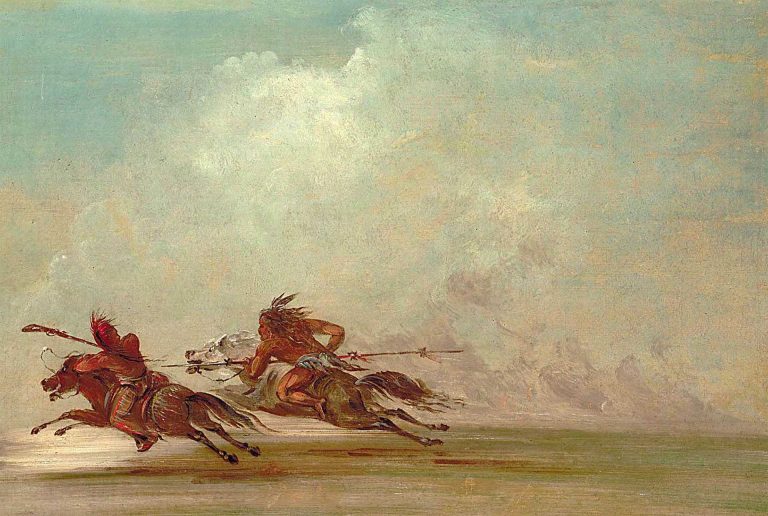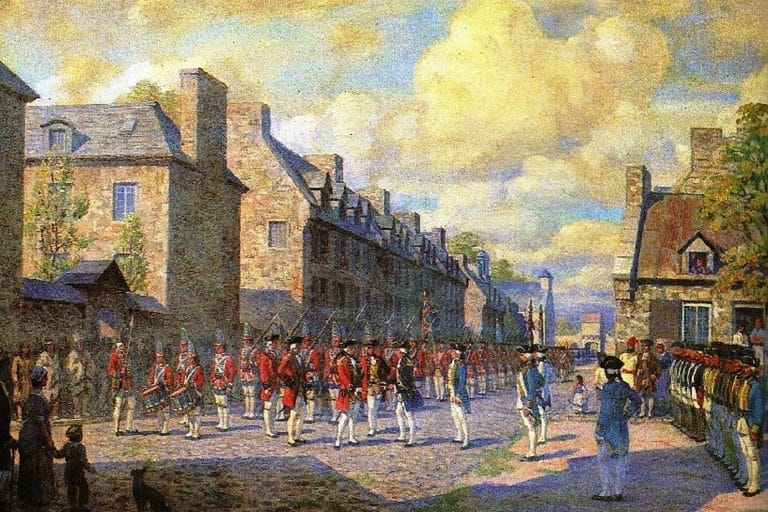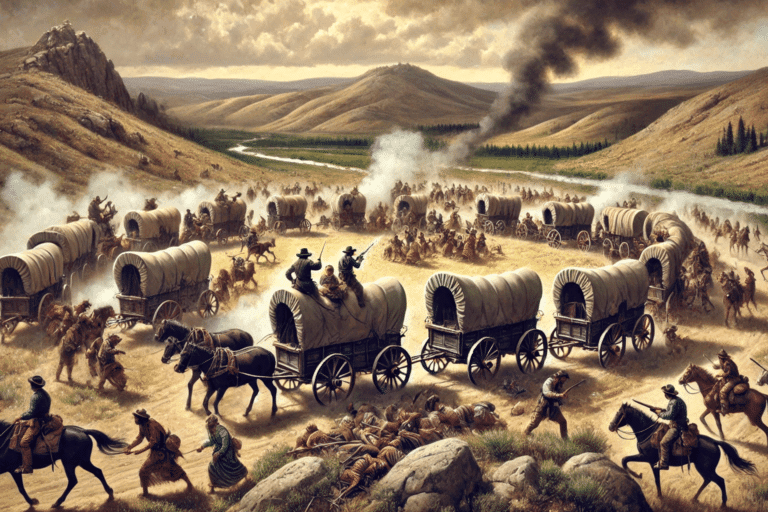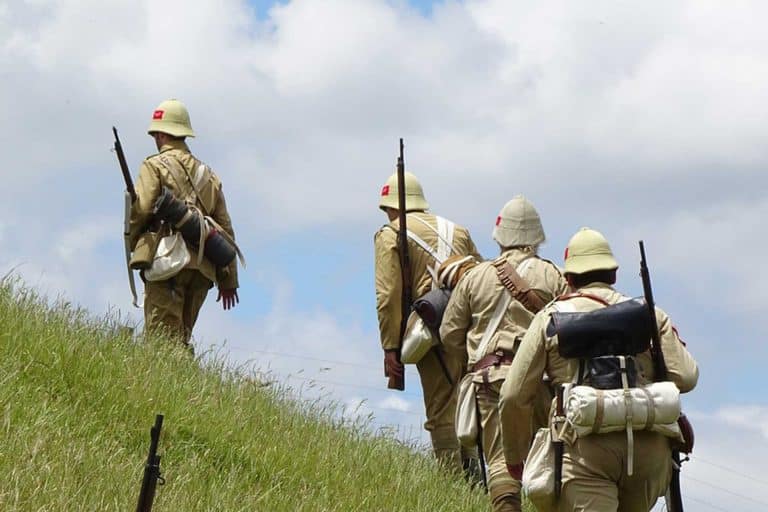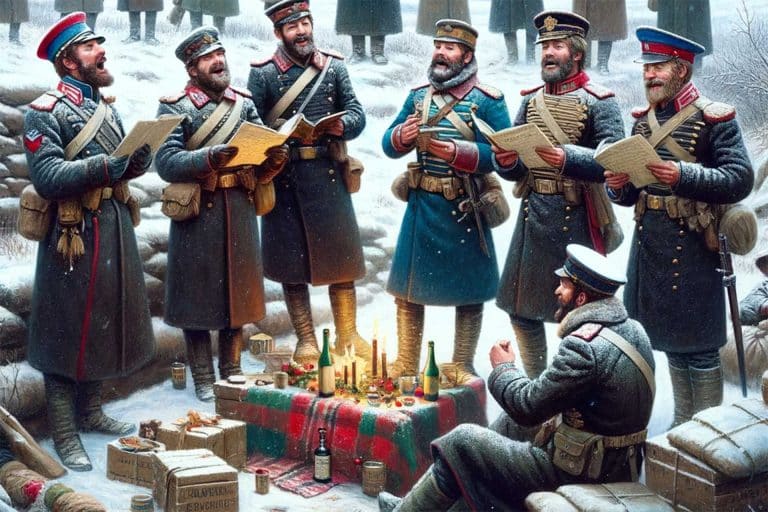Chaos in New York: The Deadly Draft Riots of 1863
In July 1863, while the Union celebrated victory at Gettysburg, chaos erupted on the streets of New York City. The New York City Draft Riots, which lasted from July 13 to July 16, quickly became one of American history’s bloodiest episodes of civil unrest. Sparked by outrage over the Union’s Enrollment Act, which conscripted men into military service but allowed the wealthy to buy their way out, working-class anger turned violent. Irish immigrants, fearing competition from freed Black workers and resenting the war’s direction, led mobs that attacked draft offices, homes, and entire communities.
The violence revealed the explosive combination of class resentment, racial hostility, and war fatigue simmering beneath the surface of Northern society. African American New Yorkers were particularly targeted—lynched, beaten, and driven from their homes. As federal troops marched back from Gettysburg to restore order, the riots left over 100 people dead and entire neighborhoods scarred. More than just a reaction to the draft, the upheaval laid bare the Union’s internal divisions and the price of a war fought on both military and moral fronts.
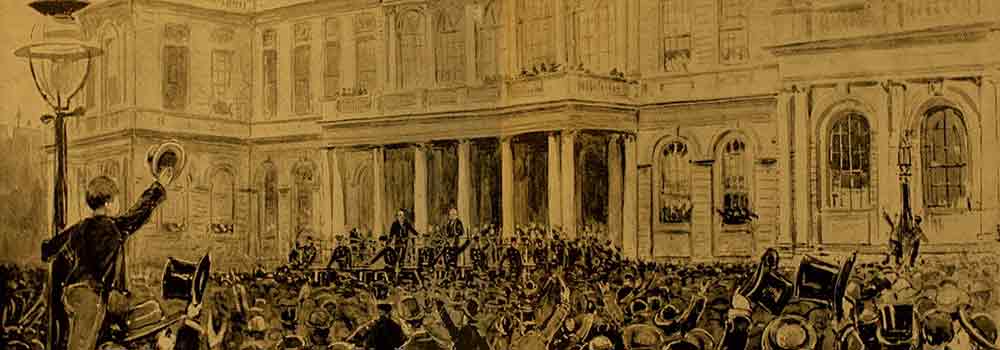
Background to the Riots
By 1863, the Civil War had considerably strained life in New York City. As the war dragged into its third year, economic hardship, mounting casualties, and growing political divides created a volatile atmosphere. The city’s working-class communities, particularly Irish immigrants, were already feeling marginalized and resentful. Many held low-paying, grueling jobs and faced prejudice from both nativist groups and local institutions. Into this already charged environment came new federal policies that, while aimed at sustaining the Union war effort, further deepened feelings of injustice and inequality.
At the heart of the unrest was a widespread fear of economic displacement. Many white laborers believed that the emancipation of enslaved people in the South would lead to an influx of free Black workers in the North, who might compete for jobs and drive down wages. Newspapers and local politicians fueled this fear, amplifying class anxieties and stoking racial tension. In Irish neighborhoods especially, the belief took hold that they were being asked to sacrifice their lives in a war that would ultimately disadvantage them economically.
Racial dynamics in the city had long been fraught. New York had strong economic ties to the South before the war, and not all citizens supported President Lincoln’s efforts at abolition. Tensions intensified as emancipation became a central war aim. Irish immigrants, already struggling to climb the economic ladder, often saw Black New Yorkers as direct competition. This perception, while shaped by racism, was also manipulated by political actors who used it to drive wedges between poor communities.
Tensions quickly escalated as war policies began to affect the home front directly. Measures taken to bolster troop numbers and support the Union war effort were perceived by many as unfair and discriminatory. While the aim was national unity and survival, the reality in New York City was a combustible mix of class resentment, economic insecurity, and racial animosity—conditions that would soon erupt into the deadliest urban disturbance in American history.
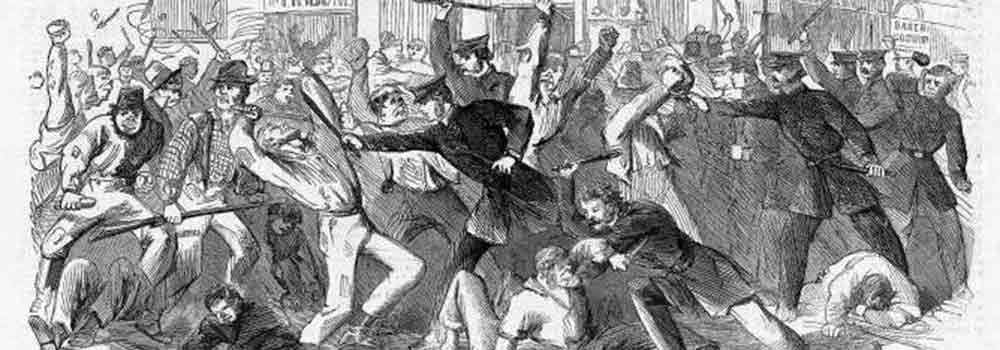
The Spark: Draft Lottery Begins
On July 11, 1863, tensions in New York City reached a boiling point as the federal government conducted its first draft lottery under the Enrollment Act. The names of eligible men were drawn at the Provost Marshal’s office on Third Avenue and 47th Street. Though the event was relatively quiet, it stirred intense anger across working-class communities, particularly among Irish immigrants.
Many viewed the draft as a policy favoring the wealthy, who could pay a $300 commutation fee to avoid service—an option well beyond the means of most laborers.
Over the weekend that followed, unease simmered. Crowds began forming in neighborhoods already seething with resentment. Rumors circulated of mass enlistments and unjust selections. Community meetings devolved into angry rallies, and local leaders warned that peace could not be maintained if the draft continued. The sense of injustice was visceral. For those living paycheck to paycheck, the draft meant potential death in a war they felt offered little benefit to them.
The situation exploded into violence on the morning of July 13. A mob gathered outside the Provost Marshal’s office just as the second day of the draft lottery was set to begin. Fueled by rage, they stormed the building, overwhelming the small security force. Draft records were destroyed, furniture smashed, and the building was set ablaze. What began as a political protest quickly devolved into widespread anarchy.
This initial attack marked the beginning of four days of chaos and bloodshed. The destruction of draft records was not just an act of protest but a symbolic rejection of federal authority. As flames consumed the office, the mob grew more emboldened, turning its fury toward other government buildings, businesses, and, increasingly, Black residents. The city’s fragile order had broken, and the worst urban violence in American history was underway.
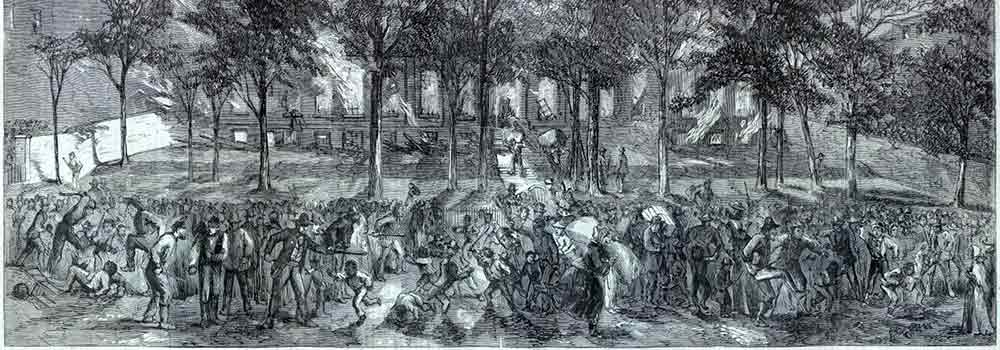
Days of Violence
As the draft office burned, the chaos quickly spread throughout Manhattan. What began as a direct protest against conscription evolved into a full-scale riot. Mobs tore through neighborhoods, attacking symbols of government power and perceived economic threats. Telegraph lines were cut to isolate the city from federal authorities, while buildings associated with the Republican Party or abolitionist causes were looted and destroyed. Fire consumed homes and businesses as rioters sought to erase the structures they believed had betrayed them.
African American citizens became the primary targets of the mob’s fury. Rioters, fueled by racism and economic anxiety, hunted down Black men, women, and even children in the streets. One of the most horrifying incidents occurred when a mob lynched 12-year-old Abraham Franklin, his body mutilated and left on display. Dozens of others suffered similar fates, beaten or murdered simply for their skin color. The violence was unrelenting and indiscriminate.
Among the most infamous events was the burning of the Colored Orphan Asylum on Fifth Avenue. Home to over 200 Black children, the asylum was looted and torched on July 13. Miraculously, the children escaped with the help of staff and sympathetic onlookers. The destruction of the orphanage symbolized the hatred at the heart of the riots—an attack not just on people but on institutions that sought to uplift Black lives.
The New York Police Department, under Superintendent John Kennedy, was quickly overwhelmed. Though officers tried to hold back the rioters, they were outnumbered and outmatched. Kennedy himself was nearly beaten to death while trying to calm a mob. Police fought block by block, often using clubs and revolvers to defend stations and protect citizens, but their efforts barely slowed the rioters’ momentum during the peak of the violence.
Throughout the city, firefighting crews refused to respond to blazes started by the mob, either out of fear or sympathy. White abolitionists and Republican politicians went into hiding, while Black families fled to the outskirts of the city or sought refuge in police stations, churches, or military installations. For several days, New York teetered on the edge of collapse as law and order evaporated under the weight of class resentment and racial hatred.
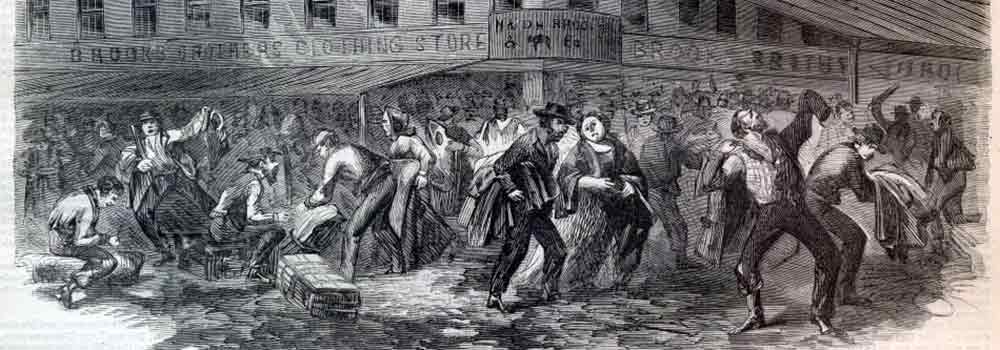
Government Response and Military Intervention
As the violence of the Draft Riots escalated across Manhattan, New York City’s municipal and state leadership appeared paralyzed. Mayor George Opdyke and Governor Horatio Seymour hesitated to act decisively during the early stages of the riots. Seymour, in particular, attempted to calm the mob by addressing them directly, calling them “my friends,” which many critics later saw as dangerously conciliatory. Their lack of immediate, forceful action allowed the chaos to spread rapidly across the city.
President Abraham Lincoln, however, took a firmer stance. Alarmed by reports of mounting destruction and unchecked violence, he authorized the deployment of federal troops. With Union forces just days removed from their victory at Gettysburg, several regiments—notably the 152nd New York and the 7th Regiment—were quickly redirected to New York City to quell the uprising. Their arrival marked a turning point in the government’s response to the insurrection.
The first federal units arrived on July 16, finding a city already battered by days of fires, looting, and lynchings. The returning Union soldiers, many still weary from combat, were nonetheless ordered into action. Skirmishes broke out in several districts as soldiers fired volleys into crowds to disperse rioters. Armed resistance met disciplined military formations, resulting in violent confrontations that finally began to restore order to the streets.
Throughout the city, troops used bayonets, rifle fire, and artillery to reclaim control of key intersections and suppress looting. Telegraph lines were repaired, and patrols secured major landmarks and neighborhoods. Though brutal in nature, these measures succeeded in dispersing the mob’s remnants. By the night of July 16, military control had been firmly reestablished, and the city’s draft rioting ended.
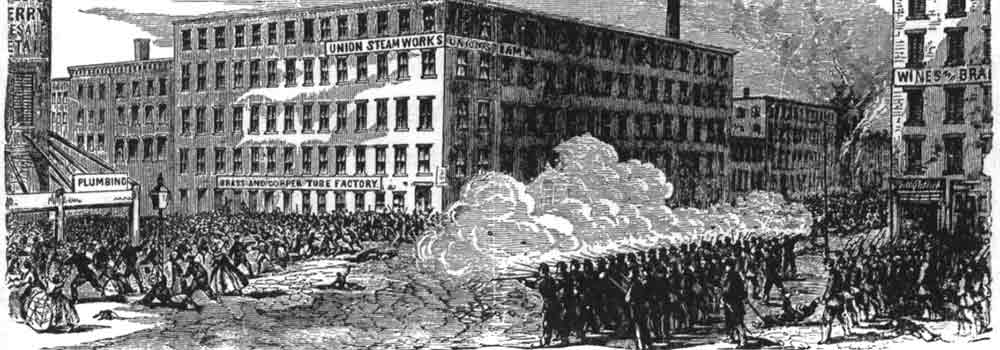
Aftermath and Legacy of the Draft Riots of 1863
The New York City Draft Riots left a deep scar on the city. Estimates of the death toll vary, with most historians agreeing that at least 120 people were killed, though some place the number higher. Property damage was estimated at around $1.5 million in 1863, the equivalent of over $45 million today. Hundreds of buildings were damaged or destroyed, and the city’s infrastructure, including telegraph lines and transit, was paralyzed for days.
The African American community bore the brunt of the violence. After the Draft Riots, many fled the city entirely. Institutions like the Colored Orphan Asylum were destroyed, and Black neighborhoods were ransacked. As a result, the city’s Black population declined sharply in the aftermath, not recovering its pre-riot numbers until decades later.
Politically, the riots dealt a blow to the Democratic Party in New York, particularly the Tammany Hall machine, which had been associated with anti-war and anti-draft sentiment. Republicans, meanwhile, used the riots as evidence of the dangers of dissent and the need for a stronger national resolve. The events exposed the vulnerability of Northern cities to internal unrest and the depth of racial and class tensions within Union territory.
Public opinion in the North began to shift. For many, the draft riots revealed that the Civil War was about preserving the Union and confronting deep-seated societal inequalities. Support for emancipation strengthened in some quarters, while others hardened their stance against the war. The uprising complicated the narrative of a unified North and revealed the fractures beneath the surface.
In the following decades, the Draft Riots were remembered with a mix of shame and silence. Monuments were rarely erected, and survivors—particularly Black New Yorkers—were left to rebuild without public support. Recent scholarship and historical projects have worked to shed light on the full scale of the violence and its impact, ensuring that the events of July 1863 are not forgotten. The legacy of the Draft Riots continues to inform how we understand race, protest, and the costs of civil conflict.

Conclusion: Unrest Beneath the Union Banner
During a national crisis, the Draft Riots of 1863 laid bare the deep fractures within Northern society. Beneath the banner of Union and emancipation, New York City became a flashpoint for grievances rooted in race, class, and fear. The violence was not merely a reaction to conscription but a broader expression of social unrest—where longstanding resentments against the wealthy elite and newly freed African Americans erupted into chaos.
As a domestic crisis during the Civil War, the riots are a grim reminder that the struggle for justice was not confined to distant battlefields. The legacy of the Draft Riots lingers in the tensions between resistance and reform, in the fight for racial equity, and in the continuing reckoning with America’s divided past.
